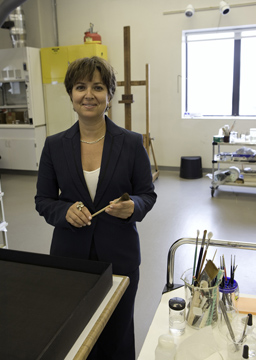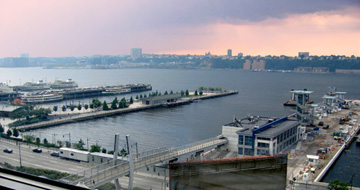
Conservator Carol Stringari with Ad Reinhardt's "Black Painting" (1960–66). Photo: Kristopher McKay, Solomon R. Guggenheim Foundation.
In August of 2008, Holland Cotter began his glowing review of Imageless: The Scientific Study and Experimental Treatment of an Ad Reinhardt Black Painting at the Guggenheim Museum in New York with this paragraph:
Things fall apart. That’s one of the facts of art. Material gets buried under other material. That’s another art fact. They are both about the meeting—sometimes gradual, sometimes sudden—of aesthetics and physics, the moment when it becomes clear to the eye that a thing of beauty, while always a joy, will not last forever, at least in its original form.
I don’t think there is a New York Times writer more understanding and sympathetic to the conservator’s role within the museum than Mr. Cotter. I remember reading that article and looking at the accompanying images and wishing I could see the exhibition. The two conservators who researched and conserved the painting and developed the exhibition were awarded the 2009 College Art Association/Heritage Preservation Award. These two conservators are Chris McGlinchey, the Sally and Michael Gordon Conservation Scientist at the Museum of Modern Art, and Carol Stringari, the Chief Conservator at the Solomon R. Guggenheim Museum.
Ms. Stringari has been at the Guggenheim since 1992, and as the Chief Conservator, she oversees a staff of six conservators who work on a wide variety of projects. Since I wasn’t able to see the exhibition Imageless myself, and because Ms. Stringari is one of the leaders and innovators in the field of the conservation of modern and contemporary art, I’ve engaged her in a discussion around some of her past and current projects in an effort to define her role in preserving art in the 21st century.
Richard McCoy: No doubt, as the Chief Conservator, that you play a number of roles at your museum. Will you describe an “average week” for you and your department?
Carol Stringari: I can’t say that there is an “average week” at the Guggenheim. Given the fact that we have a small conservation staff and a very ambitious exhibition and affiliate program, each week can be quite different. One week could include treating an artwork in the lab, installing an exhibition in Bilbao, or attending planning meetings for future projects in Abu Dhabi.
Our conservation staff is extremely busy and since we do not see each other regularly, I encourage everyone to gather weekly to share ideas and discuss projects. I feel that everyone can learn something from the larger group, regardless of their “discipline.” By discipline I mean their specialization, be it paintings, objects, works on paper, electronic art, etc.
We also have regular meetings with our curatorial department to discuss research and treatment projects, philosophical issues, and to set priorities for upcoming exhibitions.
RM: What is your involvement in site-specific and Guggenheim-commissioned projects? Does your approach differ much in these projects from working on a more traditional work of art?
CS: We have recently become more involved in the documentation of works as they enter the museum collection. With the addition of staff we are able to engage the artists early in the process and discuss working methods and materials. When possible, we photograph and preferably videotape the installation works as they are created. When this is not possible, we conduct “variable media interviews” to determine the parameters of the artwork and how it might transform over time and in different contextual circumstances. These interviews enable us to document specific technologies and how the use of technology creates meaning within an artwork.
Fundamentally, the questions we ask are the same as for traditional artworks: How do we retain the integrity of the work? How do we preserve historical and cultural context? And how do we conserve the work for future generations? The answers to these questions can vary dramatically based on the nature of the work and the artist that created it. We own a very wide range of artworks, from quite traditional objects to conceptual art, earthworks, large installations, and technology-based works.
RM: It’s becoming increasingly common for museum to create exhibitions that either feature the work of conservators or include content related to our work. (Ms. Stringari co-curated the 2004 show at the Guggenheim, Seeing Double: Emulation in Theory and Practice.) It also seems art critics are paying closer attention to conservators’ work. Do you think that your experiences in these two shows have changed the way you approach conservation?
CS: I don’t think they have changed my approach, but I have learned quite a bit from the public and professional reaction to these exhibitions. It is quite interesting to hear the misconceptions about conservation and how little is known about the work we do behind the scenes. I think it is useful and exciting to have the opportunity to discuss this work with various types of people who have rich and stimulating ideas. We have held symposia related to both the Reinhardt and Seeing Double exhibitions, which were well-attended and scholarly, with participants from many disciplines and fields.
Grahame Weinbren and Roberta Friedman, "The Erl King," 1982-1985. Installation view as part of "Seeing Double: Emulation in Theory and Practice," Solomon R. Guggenheim Museum, New York, 2004
RM: You played a major role in founding the Variable Media Network, which was created “to explore the problems inherent in preserving the kinds of nontraditional media that comprise much modern and contemporary art.” One of the big issues I deal with a lot is the notion of the representation of an artwork changing. Many artworks in the Indianapolis Museum of Art’s collection have futures that may be limited and destined to change; most often it is technology that forces them to change. What are some of your experiences in changing an artwork (good ones and bad ones)?
CS: This is a very large question and I have seen so much change (both good and bad) in my career. I have seen change imposed by conservation treatments, and I have seen change due to negligence. I have also seen beautiful changes that occur with time, and I am often very tolerant of this change. My most “famous” example is the Guggenheim’s Expanded Expansion by Eva Hesse which, over time, has altered significantly from its original soft and supple latex, but I still feel it has enormous impact and meaning in its deteriorated state (but there are many who do not concur).
Migration of media and technological upgrades are quite common, although I do tend to prefer a vintage system based on my own aesthetic preferences. However, ideologically in some cases the “right” approach is to use the latest technology and document the previous iterations for the archives.

Eva Hesse, "Expanded Expansion," 1969. Reinforced fiberglass poles and rubberized cheesecloth. Overall: 122 x 300 inches; Three units of three, five, and eight poles, respectively: 122 x 60 inches; 122 x 120 inches; 122 x 180 inches. Solomon R. Guggenheim Museum, Gift, Family of Eva Hesse, 1975. 75.2138.
(You can watch Ms. Stringari and others discuss Eva Hesse’s work Expanded Expansion on the Getty’s website, from the 2008 conference “The Object in Transition: A Cross Disciplinary Conference on the Preservation and Study of Modern and Contemporary Art,” which was presented by the Getty Conservation Institute and the Getty Research Institute)
RM: Do you have any more exhibitions in the works? If not, what would be a “Dream Exhibition” that you’d like to work on?
CS: I think it would be interesting to work with artists to create an exhibition that looked at decay and deterioration in an innovative way. This exhibition would challenge some of the prosaic ideas about how things fall apart and what should be done about that.
I think it is important to provoke and encourage discourse around the topic, so that we conservators do not become entrenched in our views. Last semester I taught an art history course at NYU’s Institute of Fine Arts entitled “Subjectivity and the Preservation of Contemporary Art.” I enjoy exploring this subjectivity and I think it forces everyone to reconsider their positions and agendas.
RM: While I’ve been in the conservation departments of most major museums in New York, I’ve never been in the Guggenheim’s. Will you tell me about it?
CS: Some people may be surprised to know that our conservation lab is not actually located within the museum. While this can sometimes be challenging, our department functions well because the conservators on staff are so talented and flexible. However, I’m happy to say that we have just been funded by New York City and State agencies to build a small lab on the 9th floor of the Gwathmey Siegel addition to the Frank Lloyd Wright building on 5th Avenue. We are currently working on the design of this small but very necessary space within the museum.
RM: What are the current projects in your lab?
CS: As I mentioned, we are doing all sorts of projects here at once, so here’s a list of some of the major ones:
- Inventorying the collection
- Studying the materials and techniques of Vassily Kandinsky
- Digitizing and documenting video works in the collection
- Designing the conservation lab for the 5th Avenue building
- Designing a new storage facility
- Preparing for upcoming exhibitions in Abu Dhabi
- Researching Constantin Brancusi’s working practices for upcoming treatments
- Researching and documenting the conceptual aspect of the collection of Italian Count Giuseppe Panza di Biumo and his wife, Giovanna, which was acquired by the museum in 1991 and 1992. You can see selections from the 350 works of Minimalist, Post-Minimalist, and Conceptual art here.
RM: If you could replay one day that you’ve had working for the Guggenheim, what would it be?
CS: Probably a day when I was all alone in the lab, sitting by a window, restoring a painting and fully concentrating on my work with no interruptions.
RM: Does your office have a nice view?
CS: Actually, yes! We have a beautiful view overlooking the Hudson River so we often get to see sensational sunsets.

Carol Stringari's view from her office



